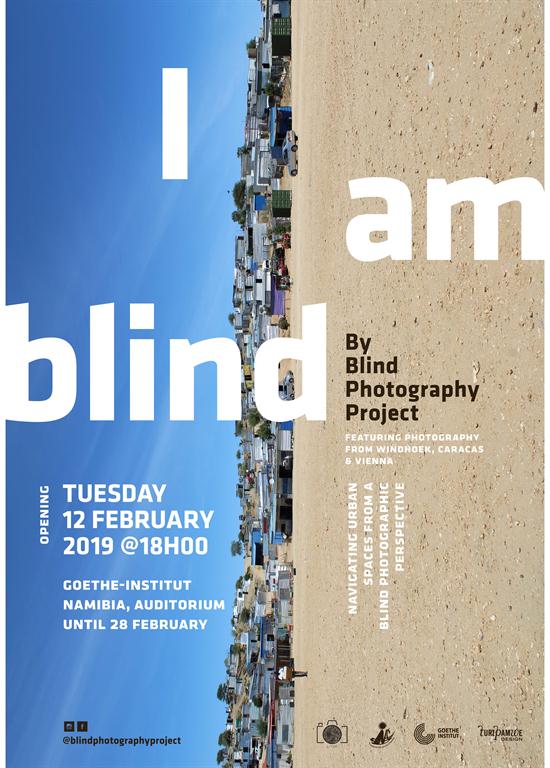'I am blind'
The first exhibition for 2019 at the Goethe Institute Namibia, I am blind, which stems from the Blind Photography Project, captures the perception and experiences of visually impaired persons through photography.
By using photography as a tool in this exhibition, the project aims to explore new ways of looking at the city, building bridges between the sighted and visually impaired, and challenge the common assumptions about the lack of that sense. The exhibition's opening is scheduled for 12 February, 18:00 and it is open to the public until 28 February.
The Blind Photography Project was founded in 2015 by Alejandro Loreto in Vienna, Austria, who thereafter applied the same concept in Caracas, Venezuela. It was then that Namibian communication and social designer Laschandré Coetzee joined the project, and together they developed the concept of the exhibition and the expansion of the project.
In the interactive exhibition, the photographic works by the visually impaired in Vienna, Caracas and now Windhoek, are presented together with the stories of these photographs, but all written in braille.
The photo without the story is not enough and in the same way, the story without the photo cannot be fully understood.
“Blind people are hidden in our city, so it's about creating a space and point of interaction which isn't usually experienced. Every set of photographs will be accompanied by text written in braille as a point of having viewers engage with the visually impaired to gain a better understanding of their reality and experiences,” Coetzee said. In Namibia, the project collaborated with three visually impaired persons, accompanying them on photographic excursions throughout Windhoek. All photographs remain unedited.
“Able-bodied people don't actually realise what we are capable of and to be honest, neither did I. I have many visually impaired friends who are crazy about taking photographs and I never understood it, but I have to admit that there is something enjoyable about taking pictures. Even though I can't see them, it is something that I created and can share with others.
“This project shows people that we are capable of doing something fun and be good at something so far out of league,” said Leticia Bouwer, a participant in Windhoek.
“I like creating things within the minds of people which seem to be impossible in their idea of the world. And I'm sure that for many, being blind and taking pictures is one of those things. Some might just shake their heads in wonder, but for others, it might even open new perspectives about the great diversity of the world,” said Angela Engel, a participant in Vienna.
STAFF REPORTER
By using photography as a tool in this exhibition, the project aims to explore new ways of looking at the city, building bridges between the sighted and visually impaired, and challenge the common assumptions about the lack of that sense. The exhibition's opening is scheduled for 12 February, 18:00 and it is open to the public until 28 February.
The Blind Photography Project was founded in 2015 by Alejandro Loreto in Vienna, Austria, who thereafter applied the same concept in Caracas, Venezuela. It was then that Namibian communication and social designer Laschandré Coetzee joined the project, and together they developed the concept of the exhibition and the expansion of the project.
In the interactive exhibition, the photographic works by the visually impaired in Vienna, Caracas and now Windhoek, are presented together with the stories of these photographs, but all written in braille.
The photo without the story is not enough and in the same way, the story without the photo cannot be fully understood.
“Blind people are hidden in our city, so it's about creating a space and point of interaction which isn't usually experienced. Every set of photographs will be accompanied by text written in braille as a point of having viewers engage with the visually impaired to gain a better understanding of their reality and experiences,” Coetzee said. In Namibia, the project collaborated with three visually impaired persons, accompanying them on photographic excursions throughout Windhoek. All photographs remain unedited.
“Able-bodied people don't actually realise what we are capable of and to be honest, neither did I. I have many visually impaired friends who are crazy about taking photographs and I never understood it, but I have to admit that there is something enjoyable about taking pictures. Even though I can't see them, it is something that I created and can share with others.
“This project shows people that we are capable of doing something fun and be good at something so far out of league,” said Leticia Bouwer, a participant in Windhoek.
“I like creating things within the minds of people which seem to be impossible in their idea of the world. And I'm sure that for many, being blind and taking pictures is one of those things. Some might just shake their heads in wonder, but for others, it might even open new perspectives about the great diversity of the world,” said Angela Engel, a participant in Vienna.
STAFF REPORTER





Comments
Namibian Sun
No comments have been left on this article